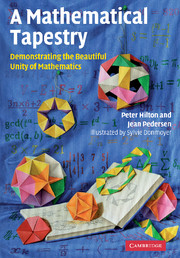Book contents
- Frontmatter
- Contents
- Preface
- Acknowledgments
- 1 Flexagons – A beginning thread
- 2 Another thread – 1-period paper-folding
- 3 More paper-folding threads – 2-period paper-folding
- 4 A number-theory thread – Folding numbers, a number trick, and some tidbits
- 5 The polyhedron thread – Building some polyhedra and defining a regular polyhedron
- 6 Constructing dipyramids and rotating rings from straight strips of triangles
- 7 Continuing the paper-folding and number-theory threads
- 8 A geometry and algebra thread – Constructing, and using, Jennifer's puzzle
- 9 A polyhedral geometry thread – Constructing braided Platonic solids and other woven polyhedra
- 10 Combinatorial and symmetry threads
- 11 Some golden threads – Constructing more dodecahedra
- 12 More combinatorial threads – Collapsoids
- 13 Group theory – The faces of the trihexaflexagon
- 14 Combinatorial and group-theoretical threads – Extended face planes of the Platonic solids
- 15 A historical thread – Involving the Euler characteristic, Descartes' total angular defect, and Pólya's dream
- 16 Tying some loose ends together – Symmetry, group theory, homologues, and the Pólya enumeration theorem
- 17 Returning to the number-theory thread – Generalized quasi-order and coach theorems
- References
- Index
16 - Tying some loose ends together – Symmetry, group theory, homologues, and the Pólya enumeration theorem
Published online by Cambridge University Press: 10 November 2010
- Frontmatter
- Contents
- Preface
- Acknowledgments
- 1 Flexagons – A beginning thread
- 2 Another thread – 1-period paper-folding
- 3 More paper-folding threads – 2-period paper-folding
- 4 A number-theory thread – Folding numbers, a number trick, and some tidbits
- 5 The polyhedron thread – Building some polyhedra and defining a regular polyhedron
- 6 Constructing dipyramids and rotating rings from straight strips of triangles
- 7 Continuing the paper-folding and number-theory threads
- 8 A geometry and algebra thread – Constructing, and using, Jennifer's puzzle
- 9 A polyhedral geometry thread – Constructing braided Platonic solids and other woven polyhedra
- 10 Combinatorial and symmetry threads
- 11 Some golden threads – Constructing more dodecahedra
- 12 More combinatorial threads – Collapsoids
- 13 Group theory – The faces of the trihexaflexagon
- 14 Combinatorial and group-theoretical threads – Extended face planes of the Platonic solids
- 15 A historical thread – Involving the Euler characteristic, Descartes' total angular defect, and Pólya's dream
- 16 Tying some loose ends together – Symmetry, group theory, homologues, and the Pólya enumeration theorem
- 17 Returning to the number-theory thread – Generalized quasi-order and coach theorems
- References
- Index
Summary
Symmetry: A really big idea
The concept of symmetry plays a strong role today in many of the exact sciences. Thus, for example, theoretical physicists, in searching for a unified field theory, have been led to the notion of supersymmetry, applied to the (super)strings, which, as some believe, are the fundamental building blocks of the Universe. Perhaps the foremost exponent of this position is the American physicist Edward Witten, of the Princeton Institute of Advanced Study, who, a few years ago, won a Fields Medal – the most prestigious award that can be given to a mathematician – for his fundamental theoretical contributions to superstring theory. Even more recently (August, 1998, at the International Congress of Mathematicians held in Berlin) the Cambridge mathematician Richard Borcherds was awarded a Fields Medal for his contribution to the development of symmetry theory, especially with respect to Witten theory and its relation to the sporadic finite groups.
What, then, is symmetry? In this chapter we attempt to make the idea precise, keeping our applications of the concept at a level where, as we hope, they will be appreciated by our readers. We will confine ourselves to the use of the symmetry concept within mathematics; and we must first of all emphasize that notions of symmetry, while fundamental to geometry, are certainly, and importantly, to be found in areas of mathematics outside geometry.
- Type
- Chapter
- Information
- A Mathematical TapestryDemonstrating the Beautiful Unity of Mathematics, pp. 236 - 259Publisher: Cambridge University PressPrint publication year: 2010

